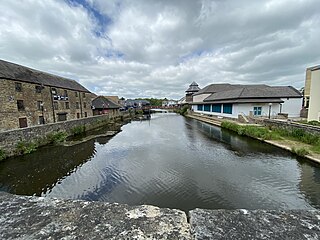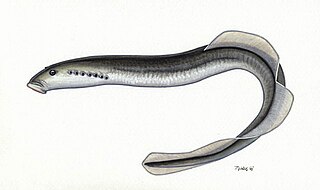
The sea lamprey is a parasitic lamprey native to the Northern Hemisphere. It is sometimes referred to as the "vampire fish". In its original habitats, the sea lamprey coevolved with its hosts, and those hosts evolved a measure of resistance to the sea lampreys.

The brook lamprey, also known as the European brook lamprey and the western brook lamprey is a small European lamprey species that exclusively inhabits freshwater environments. The species is related to, but distinct from, the North American western brook lamprey.

The Arctic lamprey, also known as the Japanese river lamprey or Japanese lampern, is a species of lamprey, a jawless fish in the order Petromyzontiformes. It inhabits coastal freshwater habitat types in the Arctic. Some populations are anadromous, spending part of their lives in the ocean. It is the most common and widespread lamprey in the Arctic region.
Mordacia mordax, known as the short-headed lamprey, Australian lamprey or Murray lamprey, is a species of Mordacia that lives in south-eastern Australia and Tasmania. Mordaciidae is made up of three species: M. praedox, M. mordax, and M. lapicida. M. mordax is a relatively rare, parasitic vertebrate and, along with the hagfishes, is part of the only surviving group of jawless organisms throughout vertebrate evolution. It has a thin eel-like body up to 50 cm (20 in) long, with two low dorsal fins on the back half. The skin is blue-gray or brown. Its eyes are small, and located on the top of its head.

The pouched lamprey, also known as the piharau in the North Island, korokoro,kanakana in the South Island, or wide-mouthed lamprey, is a species in the genus Geotria, which is the only genus in the family Geotriidae. The second species in the genus is the Argentinian lamprey, which was revalidated as a separate species in 2020. The pouched lamprey is native to the southern hemisphere. It spends the early part of its life in fresh water, migrating to the sea as an adult, and returning to fresh water to spawn and die.

The Pacific lamprey is an anadromous parasitic lamprey from the Pacific Coast of North America and Asia in an area called the Pacific Rim. It is a member of the Petromyzontidae family. The Pacific lamprey is also known as the three-tooth lamprey and tridentate lamprey.

The western brook lamprey is a small (<18 cm), widely distributed, non-parasitic species of jawless fish endemic to the freshwater coastal waterways of the Western United States and Canada. Its range extends from the North American Pacific coast from Taku River, southern Alaska, Queen Charlotte Islands, to central California, including Vancouver Island, with major inland distributions in the Columbia and Sacramento-San Joaquin watersheds.

The River Cleddau consists of the Eastern and Western Cleddau rivers in Pembrokeshire, west Wales. They unite to form the Daugleddau estuary and the important harbour of Milford Haven.

Lethenteron appendix, the American brook lamprey, is a common non-parasitic lamprey in North America. In adults their disc-like mouths contain poorly developed teeth, useless for attaching to a host.
The silver lamprey is a lamprey commonly found in the Northern and Central United States, as well as a large part of southern Canada. Its binomial name means "sucking fish" in Greek and "one-pointed" in Latin. The silver lamprey is a member of the class Agnatha, sometimes referred to as cyclostomes (round-mouths). Other common names include: bloodsucker, blue lamprey, hitch-hiker, lamper, lamprey eel, northern lamprety. The silver lamprey should not be confused with the sea lamprey, which has caused considerable damage to native fish populations in the Great Lakes region.
The mountain brook lamprey or Allegheny brook lamprey is a lamprey found in parts of the Mississippi River basin, New York, Pennsylvania, Ohio, and in the Cumberland River and Tennessee River. This fish is jawless with a small sucker mouth and a long, eel-like body. It is fairly small, only growing to about 8 inches (20 cm) in length.

The northern brook lamprey is a freshwater fish in the family Petromyzontidae. It is closely related to the silver lamprey and may represent an ecotype of a single species with I. unicuspis.

Eudontomyzon danfordi, the Carpathian brook lamprey or Danube lamprey, is a species of lamprey in the family Petromyzontidae. It is found in Austria, Bosnia and Herzegovina, Bulgaria, Croatia, Czech Republic, Hungary, Moldova, Romania, Serbia, Montenegro, Slovakia, and Ukraine. Unlike other brook lampreys, this fish is parasitic.

Lampetra is a genus of lampreys in the family Petromyzontidae.

The lake lamprey, Entosphenus macrostomus, also known as the Vancouver lamprey or Cowichan lamprey, a recent derivative of the Pacific lamprey, is a species of freshwater lamprey endemic to two North American lakes: Lake Cowichan and Mesachie Lake in Vancouver Island, Canada. The lamprey was originally called the Vancouver Island lamprey, until an error in filing shortened it to the Vancouver lamprey. The alternate common name of "Cowichan lamprey" was coined and promoted by the species' describer, Dr. Dick Beamish, who originally identified the species in the 1980s.

Mordacia lapicida, also known as the Chilean lamprey, is a species of southern topeyed lamprey endemic to southern Chile, where it can be found in riverine and marine habitats. This species is anadromous. This parasitic lamprey can reach a length of 54 centimetres (21 in) SL. Ammocoetes and adults of this species are found in rivers, and occur in fine sand along river banks. The life cycle of a Mordacia lapicida is divided into three life stages: freshwater rearing, an ocean parasite and an adult spawning stage. Once in the adult stage, individuals migrate into marine waters where they attack and attach themselves to marine fishes.

Lampreys are a group of jawless fish comprising the order Petromyzontiformes. The adult lamprey is characterized by a toothed, funnel-like sucking mouth. The common name "lamprey" is probably derived from Latin lampetra, which may mean "stone licker", though the etymology is uncertain. Lamprey is sometimes seen for the plural form.
The Caspian lamprey, Caspiomyzon wagneri, is a species of lamprey native to the Caspian Sea, and a member of the Petromyzontidae family. This species is a non-parasitic lamprey that feeds on animal carcasses.
The least brook lamprey is a common, non-parasitic lamprey distributed in the Mississippi River watershed, and a limited range along the Atlantic coast.

Lampetra ayresii is a species of lamprey in the family Petromyzontidae. It is also called the river lamprey or western river lamprey. It is found in the eastern Pacific, specifically from Tee Harbor, Juneau in Alaska to the Sacramento–San Joaquin drainage in California, USA. It can survive in both marine surface waters and freshwater lakes, rivers, and creeks. In freshwater, it is found typically in the lower portions of large river systems. It is a predatory fish and feeds on fishes in the size range of 10–30 cm. It feeds by attaching to prey using its round, sucker-like mouth. Adult western river lampreys typically grow to about 21 cm (8.3 in) total length (TL), but can reach 31 cm (12 in) TL.


















